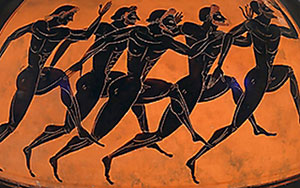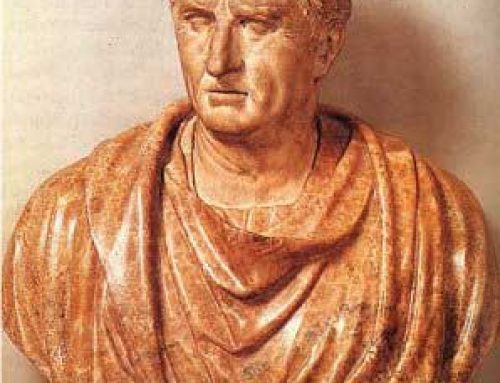
Greek Olympic events – Men’s footrace (Athens, ca. 530 BC)
A short foot race
At first, the only athletic competition at the Olympics was a single short foot race, 170 meters long. (According to one story, that was how far Herakles could run on one breath.)
More about the Olympics
All our Ancient Greece articles
For the first twelve Olympics, that’s all there was. The whole thing was over in one morning, and most of the contestants seem to have been men from Elis or nearby city-states. In the footrace, men probably wore shorts called zomas, but they ran barefoot along the dirt track. Men who were watching sat or stood along the sides on the grass.
What’s a city-state?
For prizes, the Eleians first gave out tripods (they were like trophies), and then after the first seven Olympics they gave out branches from olive trees. (To make it seem more impressive,a boy whose parents were both living had to cut the branches from Hera‘s sacred grove with a gold sickle).
The goddess Hera
Olives and olive oil

Discobolos (the Discus Thrower) (This is a Roman copy; the Greek one didn’t last)
Two longer foot races
About 724 BC the Eleians added two longer races. One was for 370 meters and the other one was 4400 meters (about three miles).
A short time after this, about 720 BC, men began to run naked, to get more speed. Some people said the first man to run naked was a Spartan named Acanthus, but other people told different stories about it. For each race there were several heats, so the weaker runners could be eliminated.
More about ancient Sparta
A race run in armor
And they had a hoplite race, where the men ran in armor (in later times anyway, they actually only wore a helmet and carried a spear).
What are hoplites?

Greek Wrestlers (ca. 200s BC, now in Uffizi, Florence)
Wrestling and the pentathlon
Then in 700 BC, the Eleians added wrestling and the pentathlon to the Olympic Games.
The pentathlon means five events. We only know what four of them were: they were running, javelin, discus, and jumping. Javelin means throwing a spear to a faraway target, and discus was throwing a heavy bronze thing like a Frisbee as far as you could. They seem to have had these events separately as well as all together, the way we do in the Olympics today.
Hold your own Olympic games
We have only two figures for the Olympic long jump in ancient times. One was 52 feet and one was 55 feet. Nobody can jump that far (the modern record is about 27 feet). So most people think this must have been for two or three jumps.
Boxing and chariot racing
And in 688 BC, the Olympic officials added boxing and chariot racing. Chariot racing was different from the other events, because the prize went to the owner of the horses, not to the charioteer. (This is still true in horse racing today).
Of course the owners of these racehorses had to be very rich, to buy such good horses and train them. It was a big status symbol to race horses at the Olympic Games; both women and men sponsored chariots.
Women in ancient Greece
Horses and chariots
By this time, the games took up five whole days – two for religious ceremonies and three for the races and fights. Now people began coming from further away. And the games got richer, and money was invented, so the organizers started to give prizes of money instead of just tree branches.
Learn by doing: hold your own Olympic games
More about Greek games
Bibliography and further reading about the Greek Olympics:
The Ancient Greek Olympics, by Richard Woff (2000). From Oxford University Press.
Hour Of The Olympics (Magic Tree House 16) by Mary Pope Osborne (1998). A good beginning reading series. You can also get a research book about the Olympics to go with this storybook.
Sport and Society in Ancient Greece, by Mark Golden (P. A. Cartledge and Peter Garnsey are series editors)(1998). Mark Golden’s an entertaining writer, and this book is a good general introduction.
The Naked Olympics : The True Story of the Ancient Games, by Tony Perrottet (2004). What were the Olympics really like? Hot, sweaty, and stinky, according to Perrottet. An entertaining read.




